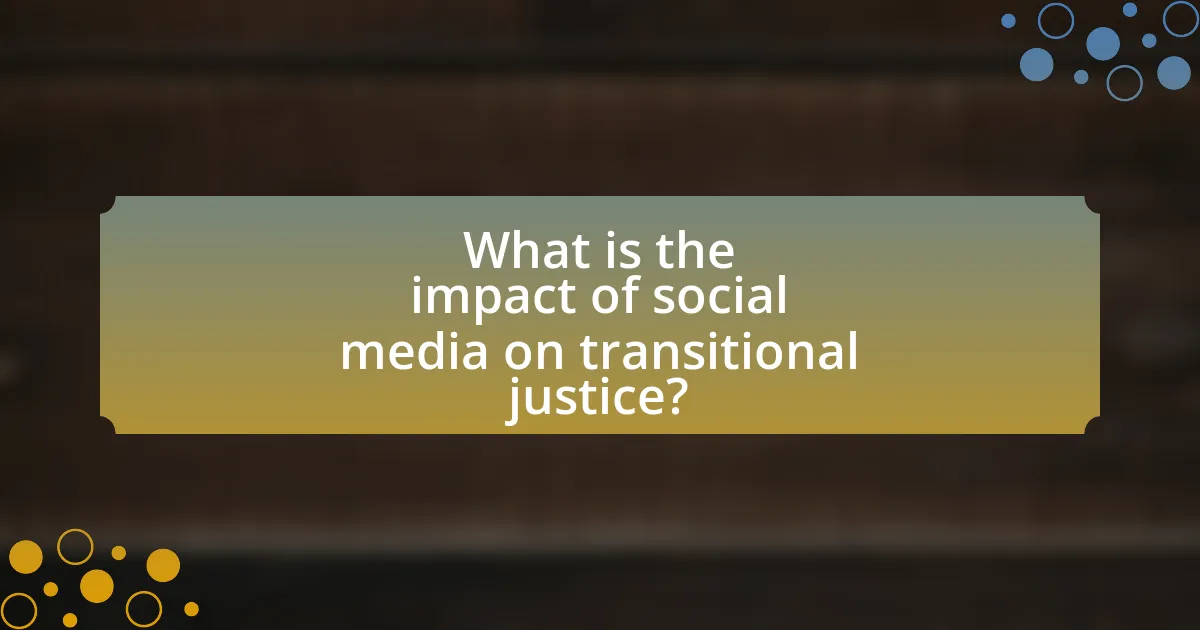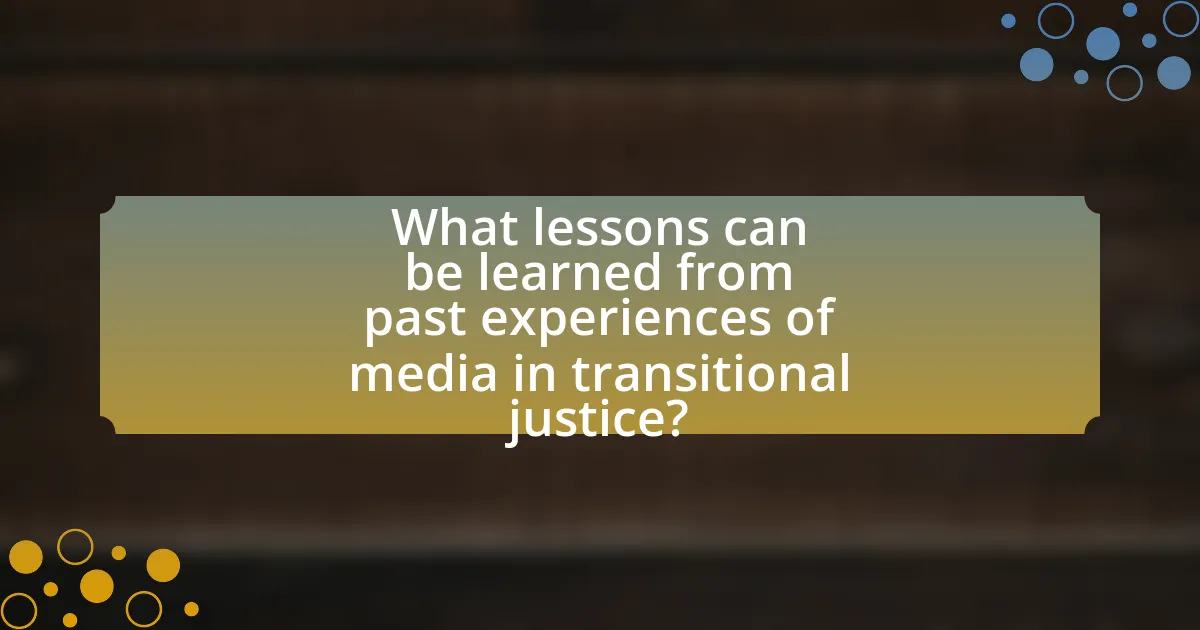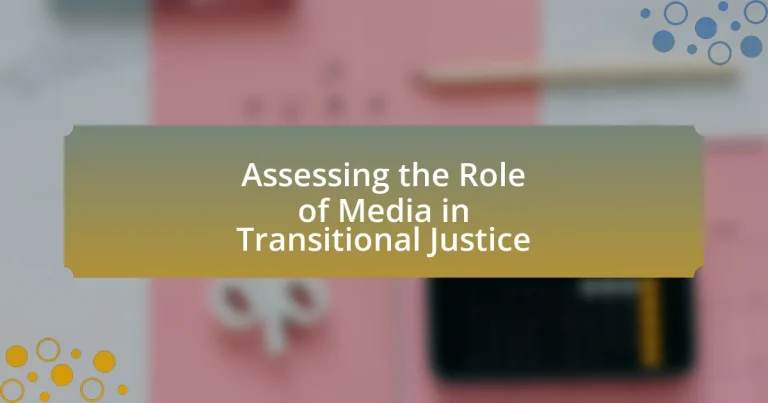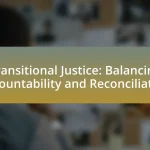The article examines the critical role of media in transitional justice, highlighting its functions in promoting accountability, facilitating public dialogue, and supporting healing in post-conflict societies. It discusses how media shapes public perception through narrative framing and representation, emphasizing the impact of various media types, including visual and social media, on transitional justice processes. The article also addresses challenges faced by media, such as censorship and bias, and outlines best practices for ethical reporting. Additionally, it explores case studies that illustrate both the successes and failures of media involvement in transitional justice, providing recommendations for enhancing media engagement in future initiatives.

What is the Role of Media in Transitional Justice?
The role of media in transitional justice is to facilitate public discourse, promote accountability, and support the healing process in post-conflict societies. Media serves as a platform for victims to share their stories, which can foster awareness and understanding of past atrocities. For instance, in countries like South Africa during its Truth and Reconciliation Commission, media coverage played a crucial role in disseminating testimonies and promoting national dialogue about human rights violations. Furthermore, media can hold authorities accountable by investigating and reporting on justice processes, thereby enhancing transparency. Studies have shown that effective media engagement can lead to increased public trust in transitional justice mechanisms, as seen in the case of Rwanda, where media initiatives helped to rebuild social cohesion after the genocide.
How does media influence public perception during transitional justice processes?
Media significantly influences public perception during transitional justice processes by shaping narratives, framing issues, and providing platforms for dialogue. Through coverage of trials, truth commissions, and reparations, media can highlight injustices and promote accountability, thereby affecting how the public understands and engages with these processes. For instance, studies have shown that media representation can either foster a sense of hope and healing or exacerbate divisions and mistrust within communities, depending on the tone and focus of the reporting. Research by the International Center for Transitional Justice indicates that media can play a crucial role in educating the public about transitional justice mechanisms, which can enhance legitimacy and support for these initiatives.
What types of media are most effective in shaping narratives in transitional justice?
Visual media, such as documentaries and films, are most effective in shaping narratives in transitional justice. These forms of media engage audiences emotionally and provide compelling visual evidence of human rights violations, which can foster empathy and understanding. For instance, documentaries like “The Act of Killing” have significantly influenced public perception and discourse surrounding the Indonesian mass killings of 1965-66 by presenting personal testimonies and historical context. Additionally, social media platforms facilitate the rapid dissemination of information and grassroots storytelling, allowing marginalized voices to share their experiences directly, as seen in movements like #MeToo and #BlackLivesMatter, which have reshaped narratives around justice and accountability.
How does media coverage impact the legitimacy of transitional justice initiatives?
Media coverage significantly impacts the legitimacy of transitional justice initiatives by shaping public perception and influencing political discourse. When media outlets provide comprehensive and balanced reporting on transitional justice processes, they enhance transparency and foster public trust, which are crucial for the perceived legitimacy of these initiatives. For instance, studies have shown that positive media portrayals can lead to increased public support for justice measures, as seen in post-conflict societies like South Africa, where extensive media coverage of the Truth and Reconciliation Commission contributed to its acceptance and effectiveness. Conversely, negative or biased media coverage can undermine these initiatives by perpetuating skepticism and resistance among the populace, as evidenced in various contexts where sensationalist reporting has led to public backlash against justice efforts. Thus, the nature and quality of media coverage play a pivotal role in either bolstering or eroding the legitimacy of transitional justice initiatives.
What are the key functions of media in transitional justice?
The key functions of media in transitional justice include promoting accountability, facilitating public dialogue, and supporting truth-telling processes. Media serves as a platform for disseminating information about human rights violations, thereby fostering accountability by exposing injustices and holding perpetrators responsible. Additionally, media facilitates public dialogue by providing a space for diverse voices, enabling communities to engage in discussions about their past and envision a shared future. Furthermore, media supports truth-telling processes by documenting testimonies and narratives of victims, which is essential for historical record-keeping and reconciliation efforts. These functions are critical in shaping public perception and contributing to the overall effectiveness of transitional justice mechanisms.
How does media facilitate accountability for past atrocities?
Media facilitates accountability for past atrocities by documenting events, amplifying survivor voices, and influencing public discourse. Through investigative journalism, media outlets uncover hidden truths about human rights violations, as seen in the coverage of the Rwandan Genocide, which brought global attention to the atrocities and pressured international bodies to act. Furthermore, media serves as a platform for victims to share their experiences, fostering a collective memory that holds perpetrators accountable. Studies, such as those by the International Journal of Transitional Justice, demonstrate that media coverage can lead to legal actions and policy changes, reinforcing the role of media in promoting justice and accountability.
In what ways does media promote healing and reconciliation in post-conflict societies?
Media promotes healing and reconciliation in post-conflict societies by facilitating dialogue, providing platforms for diverse voices, and disseminating information that fosters understanding. Through initiatives like community radio and social media campaigns, media can encourage open discussions about grievances and shared experiences, which are essential for rebuilding trust among conflicting parties. For instance, in Rwanda, radio programs played a crucial role in promoting peace and reconciliation after the genocide by broadcasting stories of survivors and encouraging forgiveness. Additionally, media can help document historical narratives, ensuring that multiple perspectives are acknowledged, which is vital for collective memory and healing. Studies have shown that inclusive media practices contribute to social cohesion and reduce the likelihood of renewed violence, highlighting the media’s significant role in transitional justice processes.
What challenges does media face in the context of transitional justice?
Media faces significant challenges in the context of transitional justice, primarily including issues of credibility, access to information, and the potential for bias. Credibility is crucial as media outlets must navigate the complex narratives surrounding transitional justice, often facing skepticism from the public and stakeholders who may view them as biased or unreliable. Access to accurate and comprehensive information is another challenge, as media may struggle to obtain firsthand accounts or official data due to restrictions imposed by governments or conflicting parties. Furthermore, the potential for bias arises when media outlets align with particular political or social groups, which can distort the portrayal of events and undermine the objectives of transitional justice. These challenges are evident in various transitional justice contexts, such as post-conflict societies where media plays a pivotal role in shaping public discourse and facilitating accountability.
How do censorship and government control affect media’s role in transitional justice?
Censorship and government control significantly undermine media’s role in transitional justice by restricting access to information and limiting public discourse. When governments impose censorship, they often prevent the media from reporting on human rights violations, historical injustices, and the narratives of marginalized groups, which are essential for fostering accountability and reconciliation. For instance, in countries like Myanmar, state-controlled media has historically downplayed military abuses, hindering the public’s understanding of past atrocities and obstructing the transitional justice process. This lack of transparency can perpetuate cycles of violence and impede efforts to establish a shared historical narrative, ultimately undermining the legitimacy of transitional justice initiatives.
What ethical dilemmas arise for journalists reporting on transitional justice issues?
Journalists reporting on transitional justice issues face several ethical dilemmas, primarily concerning the balance between truth-telling and the potential harm to individuals and communities. These dilemmas include the risk of re-traumatizing victims by revisiting painful histories, the challenge of ensuring accurate representation of complex narratives, and the ethical obligation to protect the identities and safety of vulnerable sources. For instance, when covering sensitive topics such as war crimes or human rights abuses, journalists must navigate the fine line between public interest and the privacy rights of individuals involved, as highlighted in the United Nations Educational, Scientific and Cultural Organization’s guidelines on media ethics in conflict situations. Additionally, the pressure to produce compelling narratives can lead to sensationalism, which undermines the integrity of the reporting and the transitional justice process itself.
How can media strategies be improved for better outcomes in transitional justice?
Media strategies can be improved for better outcomes in transitional justice by enhancing community engagement and ensuring accurate representation of narratives. Engaging local communities through participatory media initiatives fosters trust and encourages diverse voices, which is crucial for reflecting the complexities of transitional justice. For instance, the use of citizen journalism has been shown to empower marginalized groups, allowing them to share their experiences and perspectives, thereby enriching the public discourse. Furthermore, ensuring that media coverage is factually accurate and sensitive to the historical context can prevent the perpetuation of stereotypes and misinformation, which can undermine justice efforts. Research indicates that media framing significantly influences public perception and policy responses in transitional justice contexts, highlighting the need for strategic communication that prioritizes truth and reconciliation.
What best practices should media organizations adopt when covering transitional justice?
Media organizations should adopt a framework of accuracy, sensitivity, and inclusivity when covering transitional justice. Accuracy ensures that reports reflect the complexities of transitional justice processes, such as truth commissions and reparations, which are critical for public understanding and accountability. Sensitivity is essential to respect the experiences of victims and affected communities, avoiding sensationalism that could exacerbate trauma. Inclusivity involves engaging diverse voices, particularly marginalized groups, to provide a comprehensive perspective on justice and reconciliation efforts. These practices are supported by research indicating that responsible media coverage can enhance public trust and contribute to the legitimacy of transitional justice initiatives.
How can collaboration between media and civil society enhance transitional justice efforts?
Collaboration between media and civil society can enhance transitional justice efforts by promoting transparency, accountability, and public engagement. Media serves as a platform for civil society organizations to disseminate information about human rights violations and transitional justice processes, thereby raising awareness among the public. For instance, during the post-apartheid era in South Africa, media coverage of the Truth and Reconciliation Commission facilitated broader discussions about justice and reconciliation, leading to increased public participation in the process. This collaboration can also help document testimonies and narratives from victims, ensuring that their voices are heard and included in the transitional justice framework. Furthermore, joint initiatives can foster critical dialogue and mobilize communities, ultimately strengthening the legitimacy and effectiveness of transitional justice mechanisms.

What is the impact of social media on transitional justice?
Social media significantly impacts transitional justice by facilitating public discourse, promoting accountability, and enabling the documentation of human rights violations. It serves as a platform for victims and activists to share their experiences, thereby raising awareness and mobilizing support for justice initiatives. For instance, during the Arab Spring, social media was instrumental in organizing protests and disseminating information about state violence, which pressured governments to address grievances and pursue accountability. Additionally, social media allows for the rapid spread of information, which can influence public opinion and policy decisions related to transitional justice processes.
How does social media change the landscape of information dissemination in transitional justice?
Social media transforms the landscape of information dissemination in transitional justice by enabling rapid, widespread communication and engagement among diverse stakeholders. This immediacy allows victims, activists, and organizations to share experiences and mobilize support, often bypassing traditional media gatekeepers. For instance, during the Arab Spring, platforms like Twitter and Facebook facilitated real-time updates and coordination among protestors, highlighting human rights abuses and fostering international awareness. Additionally, social media serves as a repository for testimonies and documentation, which can be crucial for accountability processes, as seen in the use of hashtags to collect evidence of war crimes in Syria. This shift not only democratizes information flow but also amplifies marginalized voices, thereby reshaping public discourse and influencing policy decisions in transitional justice contexts.
What role does social media play in mobilizing communities for transitional justice?
Social media plays a crucial role in mobilizing communities for transitional justice by facilitating communication, raising awareness, and fostering collective action. It enables individuals and groups to share information about injustices, document human rights violations, and organize protests or campaigns. For instance, during the Arab Spring, platforms like Twitter and Facebook were instrumental in mobilizing citizens against oppressive regimes, demonstrating the power of social media in uniting communities for a common cause. Additionally, social media allows marginalized voices to be heard, amplifying calls for accountability and justice, which is essential in transitional justice processes.
How can social media be used to amplify marginalized voices in transitional justice narratives?
Social media can amplify marginalized voices in transitional justice narratives by providing a platform for direct expression and engagement. This digital space allows individuals and communities affected by conflict or injustice to share their stories, mobilize support, and challenge dominant narratives. For instance, platforms like Twitter and Facebook have been utilized during transitional justice processes in countries such as Tunisia and Colombia, where victims of human rights abuses have used hashtags to raise awareness and foster solidarity. Research indicates that social media campaigns can increase visibility for marginalized groups, leading to greater public discourse and policy attention, as seen in the #MeToo movement, which highlighted sexual violence and harassment.
What are the risks associated with social media in transitional justice contexts?
The risks associated with social media in transitional justice contexts include the potential for misinformation, polarization, and the exacerbation of social tensions. Misinformation can spread rapidly on social media platforms, leading to public confusion and undermining trust in legitimate narratives, as evidenced by instances during the Arab Spring where false information influenced public perception and action. Polarization occurs when social media amplifies divisive narratives, creating echo chambers that hinder dialogue and reconciliation efforts, as seen in post-conflict societies where opposing groups use social media to reinforce their grievances. Additionally, social media can expose individuals to threats and harassment, particularly those who speak out against prevailing narratives or seek justice, which has been documented in various transitional justice cases where activists faced online attacks.
How can misinformation on social media undermine transitional justice efforts?
Misinformation on social media can significantly undermine transitional justice efforts by distorting public perception and eroding trust in institutions. When false narratives proliferate, they can create confusion about the facts surrounding human rights violations, leading to a misinformed public that may oppose necessary reforms. For instance, during the post-conflict period in countries like Rwanda, misinformation contributed to ongoing ethnic tensions, hindering reconciliation processes. Studies have shown that misinformation can lead to increased polarization, making it difficult for communities to engage in constructive dialogue essential for transitional justice.
What measures can be taken to mitigate the negative effects of social media in transitional justice?
To mitigate the negative effects of social media in transitional justice, implementing strict content moderation policies is essential. These policies can help prevent the spread of misinformation and hate speech, which can exacerbate tensions in post-conflict societies. For instance, platforms like Facebook have developed community standards that aim to limit harmful content, demonstrating the effectiveness of such measures. Additionally, promoting digital literacy among users can empower individuals to critically assess the information they encounter online, reducing the likelihood of manipulation. Research indicates that increased digital literacy correlates with better understanding and engagement in civic matters, which is crucial in transitional justice contexts. Furthermore, fostering collaboration between social media companies and local organizations can ensure that the unique needs and sensitivities of affected communities are addressed, thereby enhancing the overall impact of transitional justice initiatives.

What lessons can be learned from past experiences of media in transitional justice?
Past experiences of media in transitional justice reveal that media can significantly influence public perception and the legitimacy of transitional processes. For instance, in post-apartheid South Africa, the Truth and Reconciliation Commission utilized media to promote dialogue and healing, demonstrating that inclusive media coverage can foster societal reconciliation. Additionally, in countries like Rwanda, media played a dual role; while it was instrumental in promoting peace during the recovery phase, it also contributed to the genocide through hate speech. This highlights the critical need for responsible media practices to prevent the spread of misinformation and incitement to violence. Furthermore, the effectiveness of media in transitional justice is enhanced when it engages diverse voices, ensuring representation of marginalized communities, as seen in the case of the Bosnian War, where inclusive narratives helped in rebuilding trust. Overall, these lessons underscore the importance of ethical media engagement and the need for frameworks that guide media’s role in supporting justice and reconciliation efforts.
What case studies illustrate the effective use of media in transitional justice?
Case studies that illustrate the effective use of media in transitional justice include the Truth and Reconciliation Commission (TRC) in South Africa and the use of radio in Rwanda post-genocide. The TRC utilized media to broadcast hearings, allowing the public to engage with testimonies and fostering national dialogue about apartheid’s atrocities. This approach helped to promote healing and accountability, as evidenced by increased public awareness and participation in the reconciliation process. In Rwanda, community radio played a crucial role in disseminating information about the genocide and promoting peace and reconciliation efforts. Research indicates that radio programs facilitated discussions on forgiveness and rebuilding communities, significantly contributing to post-conflict recovery. These examples demonstrate how media can effectively support transitional justice initiatives by enhancing public engagement and fostering dialogue.
What outcomes were achieved through media involvement in specific transitional justice cases?
Media involvement in specific transitional justice cases has led to increased public awareness, accountability for human rights violations, and enhanced victim participation in the justice process. For instance, in the case of South Africa’s Truth and Reconciliation Commission, media coverage played a crucial role in disseminating testimonies of victims, which not only informed the public but also pressured authorities to acknowledge past atrocities. Additionally, in the case of the International Criminal Tribunal for the former Yugoslavia, media reporting helped to document war crimes and facilitated international dialogue on justice, thereby contributing to a broader understanding of the need for accountability. These outcomes demonstrate that media can significantly influence the effectiveness and reach of transitional justice initiatives.
How did media failures impact transitional justice processes in historical contexts?
Media failures significantly hindered transitional justice processes in historical contexts by obstructing the dissemination of crucial information and undermining public trust. For instance, during the Rwandan Genocide in 1994, media outlets like Radio Télévision Libre des Mille Collines propagated hate speech, which not only incited violence but also distorted narratives about the conflict, complicating post-genocide reconciliation efforts. Similarly, in the aftermath of the Yugoslav Wars, biased reporting and misinformation contributed to a fragmented understanding of the events, making it difficult for transitional justice mechanisms, such as the International Criminal Tribunal for the former Yugoslavia, to gain legitimacy and effectively address war crimes. These examples illustrate how media failures can exacerbate divisions and impede the establishment of a shared historical narrative, essential for successful transitional justice.
What recommendations can be made for future media engagement in transitional justice?
Future media engagement in transitional justice should prioritize inclusive narratives that amplify marginalized voices. This approach ensures that diverse perspectives are represented, fostering a more comprehensive understanding of transitional justice processes. Research indicates that media representation significantly influences public perception and can either support or undermine justice initiatives. For instance, the United Nations has emphasized the importance of media in shaping narratives around accountability and reconciliation, highlighting that inclusive storytelling can enhance community trust and participation in transitional justice efforts. Additionally, training journalists on ethical reporting practices related to sensitive topics in transitional justice can improve the quality of coverage and reduce the risk of re-traumatization for affected communities.
How can media training for journalists improve coverage of transitional justice issues?
Media training for journalists can significantly enhance coverage of transitional justice issues by equipping them with the necessary skills to report accurately and sensitively on complex topics. This training provides journalists with a deeper understanding of transitional justice concepts, such as accountability, reconciliation, and the socio-political context surrounding these issues. For instance, a study by the International Center for Transitional Justice highlights that trained journalists are more likely to produce nuanced narratives that reflect the experiences of affected communities, thereby fostering informed public discourse. Additionally, media training often includes ethical guidelines and best practices for reporting on sensitive subjects, which can help prevent the perpetuation of stigma or misinformation.
What role should international organizations play in supporting media efforts in transitional justice?
International organizations should play a crucial role in supporting media efforts in transitional justice by providing funding, training, and resources to enhance the capacity of local media outlets. These organizations can facilitate the development of independent journalism that promotes accountability and transparency in post-conflict societies. For instance, the United Nations has historically supported media initiatives that document human rights violations and foster public dialogue, which are essential for reconciliation processes. By ensuring that media can operate freely and effectively, international organizations contribute to a more informed citizenry and help to uphold the principles of justice and truth in transitional contexts.
What practical steps can media practitioners take to enhance their role in transitional justice?
Media practitioners can enhance their role in transitional justice by prioritizing accurate reporting, fostering community engagement, and promoting inclusive narratives. Accurate reporting ensures that the complexities of transitional justice are conveyed truthfully, which is essential for public understanding and trust. For instance, the International Criminal Court emphasizes the importance of factual reporting to avoid misinformation that can undermine justice processes.
Fostering community engagement allows media practitioners to amplify the voices of marginalized groups affected by conflict, ensuring their stories are represented. This can be seen in initiatives where local journalists collaborate with communities to document their experiences, thereby creating a more comprehensive narrative of transitional justice.
Promoting inclusive narratives involves highlighting diverse perspectives and experiences, which can help build a collective memory that supports reconciliation. Research by the United Nations indicates that media representation of various societal groups can significantly influence public perceptions and attitudes towards justice and reconciliation efforts.


